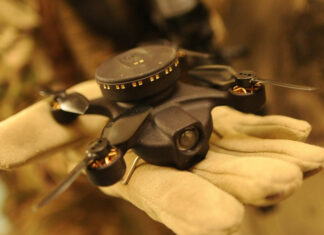“UAVs will soon fly with manned aircraft in commercial airspace” says avid Vos, Senior Director Control Technologies at Rockwell Collins.
“The growing demand for unmanned systems among military and government users is motivating the industry and government to find the ways to integrate manned and unmanned assets to operate safely in a common airspace” Vos added. UAV operations have grown in this decade from 167 systems operated by the military in 2001 only 167 UAVs operated mainly by the military and government in 2001 to 5,500 flying today. “Today, many UAVs are already flying in an airspace crowded by manned aircraft. ”Vos noted. An example for such integration is the airspace around Balad airbase in Iraq, where military helicopters, fixed wing military aircraft, commercial passenger aircraft, FedEx and UPS cargo planes are flying alongside unmanned aircraft, such as the Global Hawk, Predator and Hunter UAVs, performing 20-30 daily sorties from the airbase.
Although integration of UAVs in Civil Controlled Airspace is not yet cleared in standard regulations, unmanned aircraft are already supporting civilian emergency operations as well. In recent years UAVs were flying missions inside civilian airspace in the USA, monitoring disaster areas and emergency operations along the Red River flood area in North Dakota, surveying hurricane damage along the Gulf of Mexico, spotting fires in the Southern California mountains, surveying the Arctic and assisting police operations on a pilot test program in Los Angeles.
Vos was the founder of Athena Technologies acquired by Rockwell Collins last year. “Compared to the early unmanned systems, which hade limited situational awareness and poor safety record, today’s aerial vehicles are designed with high level of redundancy – dual, triplex and even quad redundant systems are currently available” Vos said. In addition, aviation certified engines, advanced, affordable integrated avionics that can offer automated takeoff, landing and mission control. “Automatic landing provides an essential element to another safety feature – a ‘Panic Button Emergency Landing’ enabling operators to safely abort a mission over populated area, without risk to the surrounding area” Noted Vos. After being implemented and proven in UAVs, Vos expects such essential capability could be introduced back into manned aircraft, to improve flight safety and avoid collateral damage on the ground, in case of emergency. Other elements contributing to UAV flight safety are advanced sensors offering better situational awareness; in the near future, structure damage fault tolerance will become reality, enabling a UAV to recover from bird strikes and in-flight failures.
According to Vos, once UAVs can automatically takeoff, land and perform emergency procedures enabling them to safely fly in civil airspace, their integration into the Air Traffic Management (ATM) system is required. While future NextGen ATM will support such integration, the platforms should have the means to maintain situational awareness, adherence to flight control, rules and procedures and is key to maintain flight safety. These capabilities can be supported today in the larger platforms, that have enough space and power capacity to operate communications, datalinks, IFF and 4D navigational equipment, as well as built-in capabilities to perform collision avoidance, due regard and weather radar.














